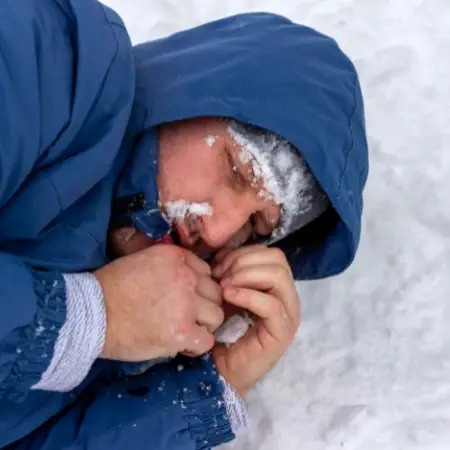Training and Assessment Delivered on Behalf of Allens Training Pty Ltd RTO 90909
Don’t Chill: First Aid For Hypothermia

Hey there, chilly readers! As the weather gets colder and the days get shorter, it’s important to be aware of the risks of hypothermia. Whether you’re out on a winter hike or just working in the cold, hypothermia can be a serious threat to your health. But don’t worry, we’ve got you covered! In this article, we’ll take a look at what hypothermia is, what causes it, and most importantly, how to do first aid for hypothermia. So sit back, grab a warm blanket, and let’s dive into the world of hypothermia first aid!
Understanding Hypothermia
Your body’s temperature is normally around 37 degrees Celsius (98.6°F). When exposed to cold temperatures, your body can lose heat faster than it can produce it, leading to hypothermia. This condition can damage organs and even cause cardiac arrest if left untreated.
Hypothermia isn’t limited to extreme situations like falling into icy waters or getting lost on a hike. It can result from staying outdoors too long during a winter event, working in cold rooms and freezers, experiencing a power outage on a freezing night, or having a medical condition that impairs the body’s temperature regulation, such as hypothyroidism or diabetes.
So, how can you recognize hypothermia, and what should you do?
Identifying Hypothermia
Mild hypothermia (32-35°C or 89.6-95°F) symptoms include shivering, pale and cool skin, impaired coordination, and slurred speech.
Moderate hypothermia occurs when the body’s temperature drops below 32°C (89.6°F), while severe hypothermia sets in below 28°C (82.4°F). At these stages, shivering may stop, muscle stiffness may occur, and responsiveness may decrease, potentially leading to unconsciousness.
First Aid for Hypothermia

To treat mild hypothermia, move the person to a warm, dry, wind-free area as quickly as possible.
Call an ambulance – the person will likely require advanced care.
Once inside, keep the person lying flat and minimize physical activity. Remove wet clothing and replace it with dry garments if available.
Prevent heat loss by raising the room temperature and wrapping them in warm woollen blankets.
Tip: if you’re treating someone with mild hypothermia, chances are you’re also in the cold. Monitor yourself and others for signs of hypothermia.
To prevent sweat-induced cooling, use plastic wrap or similar material to help reduce perspiration and retain heat.
It’s also important to give them a sugary drink! (preferably caffeine free). When the body tries to warm up, it burns a stack of energy. A sugary drink will quickly fuel the body helping the body to keep warming up. Tip: if you’re treating someone with mild hypothermia, chances are you are in the cold too, so it’s important to keep an eye on yourself and others.
Another thing you’ll want to do is prevent sweat. Sweat cools the body, and even though a person may be freezing sweat may still be present. You can use plastic such as clingwrap around the skin to help reduce sweating and keep the heat in.
Don’t Get Lit, Get Warm: The Surprising Way Alcohol Affects Your Body in the Cold
We’ve all seen it in the movies. To stay warm the character’s break out a bottle of whiskey, or in the case of the Day After Tomorrow a 12 Year Old Scotch sacrifices itself to keep everyone warm.
Does this work in reality?
Definitely not! Giving alcohol to someone with hypothermia is a big no-no. Alcohol can have negative effects on the body’s ability to regulate temperature, making it even harder for someone with hypothermia to stay warm.

When alcohol is consumed, it causes blood vessels to dilate, which can lead to increased heat loss and further hypothermia. Additionally, alcohol can cause dehydration, which can lead to decreased blood volume and impaired circulation. This can make it harder for the body to transport oxygen and nutrients to the organs and tissues that need them, including the brain and heart.
Hypothermia First Aid: Active Rewarming Explained
Another important technique that can help save a life is what is known as active rewarming. What is it? Put simply, it’s using heat packs and/or Bear Hugs to heat the person up.

Heat Packs and Blankets
In addition to the chemical heat packs, charcoal-burning heat packs, hot water bags, or electric heating blankets mentioned earlier, you can also use microwaveable heating pads, hot packs, or heated blankets. Always follow the manufacturer’s instructions to avoid skin burns, and place these heat sources on the armpit, chest, and/or back for efficient heat transfer.
Bear Hug
If you don’t have access to any external heat sources, you can use your own body heat to help warm someone with hypothermia. Remove any wet clothing from the person, and place them inside a sleeping bag or under a blanket with you. Lie down and wrap your arms around the person, creating as much skin-to-skin contact as possible. This method is most effective when both people are wearing dry clothing.
CPR and Hypothermia: Striking a Balance

When dealing with unresponsive and non-breathing hypothermia victims, it’s crucial to follow the DRSABCD plan (read our ultimate guide for more), but at the same time you also need to get them out of the cold. If they stay out in it, they are unlikely to be revived through CPR and Defibrillation. Balancing these priorities can be challenging, but the Australian Resuscitation council offers some guidelines:
- If it’s not possible to start CPR immediately (e.g., while moving the person to a safer location), consider delaying CPR onset for up to 10 minutes in cases of severe hypothermia.
- If you need to move the person and your CPR might be interupted. Alternate between at least 5 minutes of CPR and no more than 5 minutes without CPR. Resume continuous CPR as soon as possible.
Conclusion
And there you have it, frosty friends! We’ve taken a deep dive into the icy world of hypothermia and learned what it is, how to recognize it, and what to do to help someone experiencing it.
In summary, if you suspect someone has hypothermia, get them to a warm, dry place, call an ambulance, remove wet clothing, wrap them up in blankets, avoid alcohol, and use active rewarming techniques.
With these strategies in mind, you’ll be able to enjoy the beauty of winter and its activities while staying safe and warm! Ready to learn more? Check out our first aid guide!


